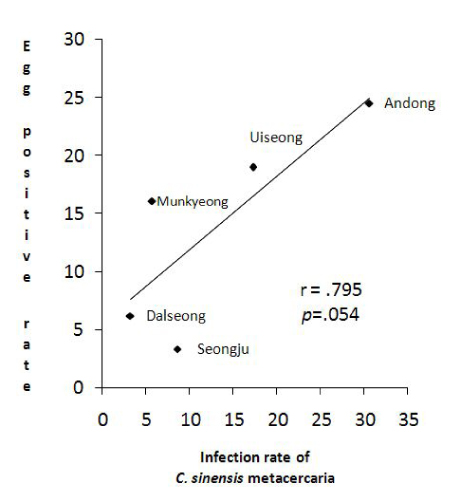J Korean Acad Community Health Nurs.
2010 Jun;21(2):242-251. 10.12799/jkachn.2010.21.2.242.
Study on Factors Related to of Clonorchiasis Infection among the Inhabitants in the Nakdong Riverside Area
- Affiliations
-
- 1Department of Public Health Graduate School, Kyungpook National University, Korea. djjy1@hanmail.net
- 2Department of Hospital & Health Care Administration Gyeongsan 1st College, Korea.
- 3Department of Nursing, ChungCheong University, Korea.
- 4Department of Nursing, MunKyung College, Korea.
- KMID: 2292904
- DOI: http://doi.org/10.12799/jkachn.2010.21.2.242
Abstract
- PURPOSE
This study investigated the factors of C. sinensis infection among the residents in vicinity of the Nakdong River and the infection status of fishes in the stream with C. sinensis maetacercaria.
METHODS
Selected five regions of the Nakdong River and collected freshwater fishes from the stream to examine their metacercarial infections; and studied the status and causes of C. sinensis infection in 552 residents living within 5 kilometers from the river.
RESULTS
Among the 552 residents studied, 13.8% were infected with C. sinensis, and among 379 freshwater fishes of 20 species collected from the five regions, 41 fishes of 8 species were infected with C. sinensis metacercaria.
CONCLUSION
In order to prevent human C. sinensis infection and transition to chronic liver ions, we need to develop and apply good programs such as continuous health education, personal hygiene improvement, active medical treatment for those infected with C. sinensis, and residents' voluntarily stop of eating freshwater fishes in the raw state.
Keyword
MeSH Terms
Figure
Reference
-
1. Baek SH, Kim JH, Gwak TD, Jung SP. The Infection pattern of clonorchis sinensis in some region of Nackdong river lower basin. J Korean Acad Fam Med. 1997; 18(7):696–705.2. Back EH. Recent patterns of infections with diagnotic Laval trematodes from freshwater fishes in tree rivers, Kyungbuk province. Daegu: Keimyung University;2009. Unpublished doctoral dissertation.3. Cho YJ, Chu JP, Rim HJ, Hwang SK. Viability of clonorchis sinensis metacercaria according to the Food-processing methods. Korean J Infect Dis. 2002; 34(4):242–247.4. Choi DW, Ahn DH, Choy CH, Kim SS. clonorchis sinensis in Kyungpook Procince, Korea (Changing pattern of clonrchis sinensis infection among inhabitants). Korean J Parasitol. 1976; 14(2):117–122.5. Chung DI, Kim YI, Lee KR, Choi DW. Epidemiological studies of ttrematodes in Youngyang county, Kyungpook province. Korean J Parasitol. 1991; 29(4):325–338.6. Hyun MC, Joo CY. Epidemiological studies of clonorchis sinensis in the upper stream areas of Naktong river. Keimyung Med J. 1994; 13(1):22–46.7. Joo CY, Chung MS, Kim SJ, Kang CM. Changing patterns of clonorchis sinensis infection in Kyongbuk. Korea. Korean J Parasitol. 1997; 35(3):155–164.8. Ju YH, Oh JK, Kong HJ, Shon WM, Kim JI, Jung KY, et al. Epidemiologic study of clonorchis sinensis infection in a rural area of Kyongsangnam-do, South Korea. J Prev Med Public Health. 2005; 38(4):425–430.9. Kang SB. Changing patterns of clonorchis sinensis infection in Yeongcheon, Kyungpook province, Korea. Taegu: Keimyung University;1997. Unpublished doctoral dissertation.10. Kim BJ, Ock MS, Kim IS, Yeo UB. Infection status of clonorchis sinensis in residents of Hamyang gun, Gyeongsangnam-do, Korea. Korean J Parasitol. 2002; 40(4):191–193.11. Kim EM, Kim JL, Choi SY, Kim JW, Choi MH, Bae YM, et al. Infection status of freshwater fish with metacercaria of clonorchis sinensis in Korea. Korean J Parasitol. 2008; 146(4):247–251.12. Korea Centers for Disease Control and Prevention. The Fourth Korea National Health and Nutrition Examination Survey-KNHANES IV-2. Seoul: Korea Centers for Disease Control and Prevention;2008.13. Korea Centers for Disease Control and Prevention, Korea Association of Health Promotion. Prevalence of Intestinal Parasitic Infection in Korea-The 7th Report. Seoul: Korean Centers for Disease Control and Prevention, Korea Association of Health Promotion;2005.14. Lee GS. Prevalence of clonorchiasis and its related factors among the inhabitants in Okcheon-gun, Korea. Daejeon: Chungnam University;2008. Unpublished doctoral dissertation.15. Lee JS, Lee WJ, Kho WG, Kim DS, In TS, Choi KS, et al. Transition of endemicity of clonorchiasis in main riverside areas in Korea. Rep Natl Ins Health. 1994; 31(1):172–192.16. Lee SH, Ahn SH, Joo CY. Epidemiological studies of clonorchis sinensis in the coastal areas of Kyungpook, Korea. Keimyung Med J. 1996; 15(4):303–326.17. Moller H, Heseltine E, Vainio H. Working group peport on schistosomes, liver flukes and Helicobacter pylori. Int J Cancer. 1995; 60(5):587–589.18. Park MD. A study on the effects of clonorchis sinensis control intervention at a sumjin riverside area (1999-2004). Gwangju: Chonnam National University;2006. Unpublished master's thesis.19. Seo BS, Lee SH, Cho SY, Chai JY, Hong ST. An epidemiologic study on clonorchiasis and metagonimiasis in riverside area in Koera. Korean J Parasitol. 1981; 19(2):137–150.20. Shin DS. Epidemiological studies of clonorchis sinensis prevailed in the people of Kyungpook Province. Korean J Parasitol. 1964; 2(1):1–13.21. Shon WM. Infection status with clonorchis sinensis metacercariae in pseudorasbora parva from a tributary rtream of Nacktongang (River) in Pusan. J Exp Biomed Sci. 2002; 8(1):7–11.22. Soh CT, Lee KT, Min DY. Prevalences ofclonorchiasis and metagonimiasis along rivers in Jenra-Nam-Do. Korea. Yonsei Rep Trop Med. 1976; 7(1):3–16.23. Song IC, Lee JS, Rim HJ. Epidemiological studies on the distribution of clonorchis sinensis infectionin Korea. Korea Univ Med J. 1983; 20(1):165–190.
- Full Text Links
- Actions
-
Cited
- CITED
-
- Close
- Share
- Similar articles
-
- Prevalence and Risk Factors of Clonorchiasis among the Populations Served by Primary Healthcare Posts along Five Major Rivers in South Korea
- Prevalence of Clonorchis sinensis Infection among Residents along 5 Major Rivers in the Republic of Korea
- Prevalence and Related Factors of Clonorchiasis among Five Major Riverside Residents in South Korea
- Prevalence of Clonorchiasis in Southern Endemic Areas of Korea in 2006
- The Infection pattern of Clonorchis Sinensis in some region of Nakdong river lower basin


